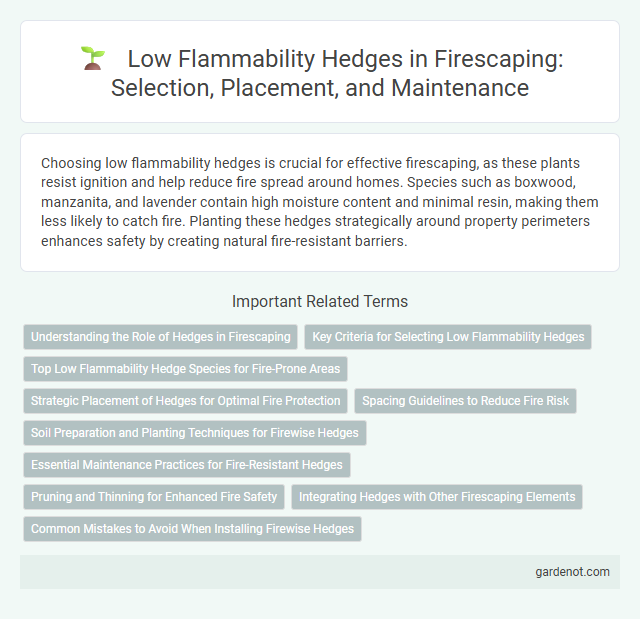Choosing low flammability hedges is crucial for effective firescaping, as these plants resist ignition and help reduce fire spread around homes. Species such as boxwood, manzanita, and lavender contain high moisture content and minimal resin, making them less likely to catch fire. Planting these hedges strategically around property perimeters enhances safety by creating natural fire-resistant barriers.
Understanding the Role of Hedges in Firescaping
Low flammability hedges play a crucial role in firescaping by acting as natural firebreaks that slow down the spread of wildfires and protect property. Plant species such as boxwood, lavender, and oleander are commonly used due to their dense foliage and moisture content, which resist ignition and reduce fire intensity. Integrating these fire-resistant hedges strategically along property lines and around structures significantly enhances fire safety and landscape resilience.
Key Criteria for Selecting Low Flammability Hedges
Selecting low flammability hedges requires evaluating plant moisture content, sap toxicity, and foliage density since these factors significantly influence fire resistance. Opt for species with high water content in leaves and minimal volatile oils to reduce ignition risk and flame spread in landscape design. Prioritizing native, drought-tolerant shrubs with compact, dense growth enhances firebreak effectiveness while supporting ecological resilience.
Top Low Flammability Hedge Species for Fire-Prone Areas
Top low flammability hedge species for fire-prone areas include rosemary (Rosmarinus officinalis), which offers dense, aromatic foliage less likely to ignite; California lilac (Ceanothus spp.), known for its high moisture content and fire resistance; and oleander (Nerium oleander), which maintains green, lush leaves during dry seasons. These species are preferred for firescaping due to their ability to slow fire spread while enhancing landscape aesthetics. Planting such shrubs strategically creates defensible spaces that help protect homes and reduce wildfire risk effectively.
Strategic Placement of Hedges for Optimal Fire Protection
Strategically placing low flammability hedges around a property creates effective firebreaks that reduce the spread of wildfire toward structures. Selecting species with dense, moisture-rich foliage, such as Oregon grape or manzanita, enhances fire resistance and slows fire progression. Positioning these hedges near vulnerable areas like driveways, patios, and along property perimeters maximizes protection while maintaining landscape aesthetics.
Spacing Guidelines to Reduce Fire Risk
Proper spacing of low flammability hedges is crucial to minimize fire spread by creating effective firebreaks. Maintain a minimum distance of 10 feet between shrubs and adjacent structures, and space plants at least 3 to 6 feet apart depending on species' mature size. Incorporate vertical and horizontal clearance to prevent ladder fuels, ensuring branches do not touch or overlap to reduce fire intensity and allow safe access for firefighting.
Soil Preparation and Planting Techniques for Firewise Hedges
Proper soil preparation is crucial for establishing low flammability hedges that enhance fire resistance. Amending soil with organic matter improves moisture retention and nutrient availability, supporting healthy root development essential for firewise plants. Planting techniques should include adequate spacing to reduce heat transfer and promote air circulation, minimizing fire risk within the hedge.
Essential Maintenance Practices for Fire-Resistant Hedges
Essential maintenance practices for fire-resistant, low flammability hedges include regular pruning to remove dead or dry foliage, which reduces fuel for potential wildfires. Irrigation should be consistent to keep plants hydrated and resilient during dry seasons, minimizing flammability risks. Clearing debris and maintaining adequate spacing between hedges enhances airflow, further decreasing fire hazard and promoting a safer landscaping environment.
Pruning and Thinning for Enhanced Fire Safety
Pruning and thinning low flammability hedges significantly reduce available fuel, lowering fire intensity and spread risk around properties. Maintaining clear spaces between branches and removing dead or overgrown vegetation improves airflow and reduces heat accumulation. Regularly scheduled pruning enhances hedge health while creating effective firebreaks critical for enhanced fire safety.
Integrating Hedges with Other Firescaping Elements
Low flammability hedges such as succulents, rosemary, and lavender create natural firebreaks when strategically placed near structures, limiting wildfire spread. Combining these fire-resistant plants with hardscape features like gravel paths and stone walls enhances overall landscape safety by reducing combustible materials. Integrating hedges with drip irrigation systems also maintains moisture levels, further minimizing fire risk in high-threat zones.
Common Mistakes to Avoid When Installing Firewise Hedges
Choosing fire-resistant hedge species and maintaining proper spacing are crucial to prevent fire spread when installing Firewise hedges. Avoid planting dense, resinous shrubs that increase fuel load and ensure regular pruning to eliminate dead or dry branches. Incorrect irrigation practices can weaken plants, making them more susceptible to ignition, so consistent watering schedules are essential for maintaining low flammability.
Low flammability hedge Infographic

 gardenot.com
gardenot.com